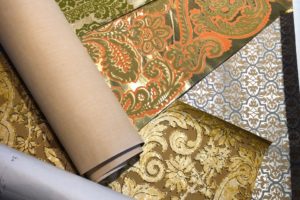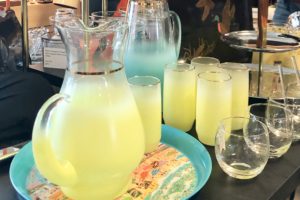Blendo Glassware Demystified: Part 2
The Many Colors of Blendo
Have you found yourself, like many before you, drawn to the vibrant and simple yet striking design of the Blendo line? It is hard not to notice them. Here we uncover some of the hidden beauty of Blendo.
In our previous post, Blendo Demystified: Part 1, Who made Blendo?, we unraveled over two decades of convoluted production history. Here, we set the production discussion aside, and take an in-depth look at colors, styles, and combinations.
To put us on sure footing, let us begin with a detailed description. Blendo glassware is a line of crystal glassware produced from 1956-1986 with a frosted sprayed-on decoration that gives an ombre effect. The color graduates from solid at the foot to clear glass at the top. “Bright gold trim” was a signature of the line. Glasses and bowls had gold on the rim, other items had a thin gold band around the neck or verge, decanters a thick gold band at the mouth.
The Blendo line consisted primarily of glasses, pitchers, and bowls in many sets and sizes. Additionally, entertaining pieces were produced like decanters, vases, salt and pepper shakers, cocktail shakers, lidded candy jars, cruet sets, ice buckets (included in the all-purpose set), lidded casserole, carousel set, lazy susan set, and the elusive canape set. Gold wire racks with wood handles were also made to accompany some sets.

One of the earliest and most recognizable Blendo color combinations is “Gala.” In 1960, Specialty devoted a full catalogue page to Gala, describing the colors as green, coral, mauve, and bluish turquoise. The catalogue stipulated that you could buy solid color sets or “4-2 assorted colored sets” (a set of eight assorted). This bright and cheerful colorway seems to be a favorite for collectors.
Another signature colorway produced in the early 1960s was two-tone “Charcoal Mist.” Easily recognizable, it features dark charcoal at the base blending into white blending to clear glass. While Charcoal Mist represents the vast majority of two-tone Blendo, there are more known examples like a pink and black or green and yellow. I found one catalogue page showing a glass and pitcher in two-tone “Mist Citron & Turquoise,” but no others. Either these catalogue pages are yet to be uncovered, or these were custom color orders. According to West Virginia Blendo Glass: Collecting Blendo from the West Virginia Glass Specialty Company, Earlo Pertz, a former president of Specialty, confirmed that sales staff could send special orders for [Blendo] combinations and colors.



While Blendo is known for its frosted look, the “Glow” series exhibits transparent color. Produced in the 1970s, Glow was offered in at least five different colors, and one multi-color combination. Rose Glow was a deep red and is the most common (often referred to as Cranberry). The other single colors were Azure, Café, Amber, and Emerald. Rain Glow was the series combination, featuring Rose, Azure, Emerald, and yellow – the early Rain had a pale yellow, and which appears to later be replaced with Amber, and the green seems to have started more olive, then transitioned to Emerald. Later catalogues expanded the Rain Glow combination and renamed it “Gems.”
One beautiful and exceedingly rare outlier to the Blendo decoration style is the “Triumph” pattern. Shown as a small series in a catalogue page from some time in the 1960s, Triumph featured a single frost color blended from the top and the bottom, leaving clear glass in the middle with a thin gold belly band. All the pitchers were shown in Fiery Pink and the coordinating glasses were two each of white, olive, and pineapple. You could also get a set of eight glasses in 12 oz. Hi-Ball Tumblers or 13 oz. Zombie/Coolers (two of each of the four colors).

Some similar products made by West Virginia Glass Specialty are often lumped in with Blendo. One example is the “Twist” line. Twist featured three bands of color blended into one another, covering the glass completely with no gold trim. At least eight Twist color combinations exist. Most have the same color top and bottom and a contrasting color in the middle. Patriot Twist has three colors – red, white, and blue. Another line often included in the Blendo family is “Candy Stripe.” These pieces have an all-over swirl frost sprayed-on decoration. While these lines are not technically Blendo, they certainly appeal to the same collectors.

What is the takeaway? The number of Blendo colors produced by Specialty was extraordinary – if pressed I might guess somewhere around fifty individual colors (not including assorted sets), but making an exact list could prove to be very difficult.
What is clear is that these collectibles continue to climb in value. Excellent condition complete beverage sets in desirable colors can run up to $200, with hard-to-find new old stock sets topping $500. The good news? For treasure hunters, it is still possible to find these hidden gems in the wild at flea markets or garage sales for pennies on the dollar, and you could flip your find for good money. Better yet, sit back and stir up a Blendo pitcher of martinis to congratulate yourself on a job well done.
Thank you to Tom Felt from the Museum of American Glass in West Virginia (MAGWV). You can purchase their many publications on American glass through their eBay store, including the monograph about Blendo referenced in this post.






















